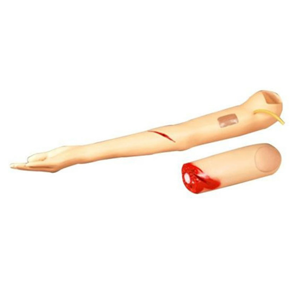

Article tag: Arm bleeding Control model| BIX/G105-2|
The Bleeding Control Arm model can provide near-real emergency training in a non-clinical setting, helping healthcare professionals accumulate rich practical experience without patient involvement. By simulating different trauma situations and providing timely data feedback, participants are able to gradually master various bleeding control techniques dur...
In the field of emergency and trauma care, bleeding control is a vital skill. In the non-clinical environment, how to provide medical staff with close to real training has become the key to improve their emergency response ability. As an efficient training device, can the bleeding Control arm model provide real-world emergency training without patient participation, help students improve their personal skills, and become an important part of the development of the industry?
1. Personal growth: Provide simulation exercises to improve clinical coping ability
For healthcare professionals facing acute trauma in a real-world clinical setting, rapid and accurate bleeding control often makes the difference between life and death for patients. However, in actual work, in the face of emergencies, medical staff often feel nervous due to lack of emergency training. The Control Bleeding Arm model provides trainees with a simulated training platform that allows them to practice repeatedly without risk. By practicing various hemostatic techniques for trauma bleeding on the model, students can improve their operational proficiency and enhance their ability to respond in emergency situations. This repeated training helps students gradually build confidence and improve their ability to deal with emergencies in the actual clinic.

2. Training equipment: efficient tools close to real situations
The Control Bleeding Arm model is well designed to simulate real bleeding conditions, including various trauma types such as arterial bleeding, venous bleeding, or skin trauma. By simulating different bleeding scenarios, the model allows participants to experience the emergency management process of an actual trauma in a non-clinical setting. This simulated environment allows participants to experience the pressure and urgency of actual operations during training, thereby better preparing them for real-world scenarios in a clinical setting. In addition, the model's adjustable and diversified scenario Settings can meet the needs of different students and help them improve their skills according to their personal progress.
3. Industry experts: improve professional level and clinical preparation
Industry experts believe that the bleeding control arm model is not only a tool for medical personnel to improve their skills, but also an important facility to promote the quality of medical education. Experts point out that traditional classroom learning often lacks practical training, and the application of models makes up for this deficiency. Through expert guidance, students can learn to choose the most appropriate hemostatic method according to different trauma types, and adjust the operation according to the feedback. This specialized training helps students to better understand the key skills in trauma treatment and enhance their ability to perform clinical operations, especially in non-clinical Settings. It provides students with ample opportunities to practice and improve their clinical readiness.
4. Data support: Feedback mechanisms promote skill improvement
The bleeding control arm model is usually equipped with a real-time data recording and feedback system that can track the student's operation and help the student understand the implementation and effect of each step. Through data analysis, participants were able to see how they performed in the simulated environment, including the accuracy of the hemostatic technique, the operation time, and the proper use of tools. This data feedback provides students with a clear basis for self-assessment, helping them to identify and improve on shortcomings in their operations. With the continuous optimization of skills, the students' emergency handling ability has also been significantly improved.
conclusion
The Bleeding Control Arm model can provide near-real emergency training in a non-clinical setting, helping healthcare professionals accumulate rich practical experience without patient involvement. By simulating different trauma situations and providing timely data feedback, participants are able to gradually master various bleeding control techniques during the training and continuously improve their skills under the guidance of experts. This training not only enhances the personal growth of the trainees, but also promotes the improvement of the standard of the entire industry in the field of emergency and trauma care. In clinical emergency situations, medical staff trained by this training can respond to various emergencies more confidently and calmly, and provide timely and accurate treatment for patients.